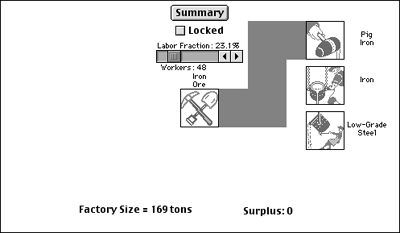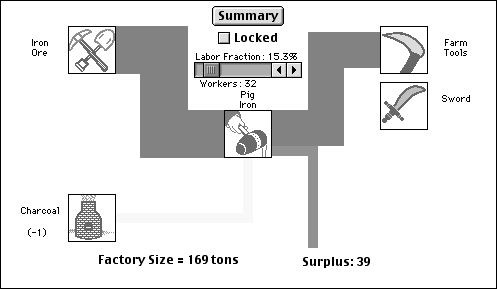The Economic System
| The economic system used in Guns & Butter was another major innovation. In most military-economic games, the only product of a country's economy is weaponry. The more sophisticated games have technological scales; the player expends resources to climb the technological scale, which in turn grants access to more modern and more powerful weapons. Sid Meier's Civilization, for example, used a system in which the player expended resources on scientific research, which in turn produced a variety of discoveries which in turn enabled more powerful weapons or more efficient economic facilities (and some other things as well). Civilization wasn't on sale when I designed Guns & Butter, so it didn't affect my design, but it employed (to my thinking) merely a more advanced form of the same old approach. My reading of history had convinced me that economic, military, and technological advances all spring from the same source: economies of scale. As a society grows more populous, more people can be diverted to more specialized efforts, which in turn permits the development of more efficient tools. Moreover, this population effect can also be achieved by pooling the populations of several countries into a single economic unit. This struck me as an excellent foundation for conflict. Players must cooperate economically if they are to grow powerful, but ultimately, they will go to war. This would, I planned, create a complex, constantly shifting pattern of alliances and conflicts. Here was the central conflict of my design.
The economic system was based on two primary inputs: resources and labor. You may object that this leaves out the third element of the "land, labor, and capital" triad that you were taught in school. My explanation for this unconventional element lies in the fact that the game covers such a large period of time that I can safely assume 100% capital depreciation from turn to turn. This approximation does not address the division between consumerism and capital formation (which, interestingly, Civilization does address), but I believed that such division could reasonably be treated as a constant. Moreover, resources were fixed by the resource base of each country. The player had no control over the availability of resources; each province provided a fixed amount of each basic resource. The player's overall resource base was simply the sum of the resource bases of each province in the country. This, of course, created strong incentives to capture provinces well endowed with resources that the player lacked. Thus, the player controlled neither capital formation nor resources. This leaves only labor as the element directly controlled by the player. And in fact, the player controlled not the absolute quantity of labor, which comes from total population, but instead the fraction of the country's workforce that is dedicated to each industry. This was quite deliberate on my part; I didn't want to inundate my player in a tidal wave of complex decisions. I wanted my game to zero in on the nature of economic strength, and so I kept the player's decisions tightly focused on the matter at hand. The player implemented his decisions with a handy little display looking like what appears in Figure 24.6. 24.6. Single-factor economic flow diagram.
Remember that screens were small back in those days; this display filled the screens of most user's computers. Also, many users still lacked color display capabilities, so the display had to work just as well in black-and-white as in color. This shows the production of iron ore. The player controls the single scroll bar at top center to allocate a greater or lesser fraction of his work force to the Iron Ore mine. The player has 48 workers at the Iron Ore mine; they produce 169 tons of iron ore, all of which goes to the Pig Iron factory. Now let's follow up that production: The player simply clicks on the Pig Iron icon and jumps to the display for the Pig Iron factory (see Figure 24.7). 24.7. Multi-factor economic diagram.
Here's what this screen means. The central element is the large icon in the center: Pig Iron. Pig iron requires two inputs: iron ore and charcoal. The output of the Pig Iron factory can be sent to either the Farm Tools factory or the Sword factory, or some combination of both. In this screen, the player has dedicated 15.3% of his workers, 32 in all, to the Pig Iron factory. This many workers can produce 169 tons of pig iron each turn. They will require, of course, enough iron ore and charcoal to manufacture the pig iron. The output of their factory goes directly to the Farm Tools factory, but that factory has a capacity of only 130 tons, which means that 39 tons of pig iron are surplus and wasted. Clearly, this player should reduce the capacity of his factory; that will reduce the waste. Of course, then there will be too much iron ore, and the player will have to reduce the number of workers at the Iron Ore mine. To do so, he merely clicks on the Iron Ore icon, and goes back to the Iron Ore screen. This system neatly allows the player to traverse an entire economy, looking at all the inputs and outputs of all the industries. Now, if you have any training in economics, you will likely be impressed by this, because input/output diagrams of economies are huge messy affairs that everybody hates except they are so useful that they can't be avoided. My design does for input/output diagrams what Excel does for spreadsheets: It makes them fully interactive and instantly modifiable! Boy, was I ever proud of myself. A great idea it may have been, but it turned out during gameplay that it really wasn't that much fun to work with. Sure, it was clean and easy to use, and you could readily trace the entire flow of goods through your economy, but during gameplay, you really didn't want to spend much time admiring the details of your economy. There really weren't many interesting decisions you could make with your economy. Yes, there was always the fundamental "guns and butter" decision of improving your economy versus developing powerful armies, but that decision didn't require a detailed analysis of the economy. It really could have been made with a single scroll bar. Although the input/output aspect of the game was clean and easy, it just wasn't much fun to play with.
What could I have done to fix the problem? I think that my mistake here was keeping the problem one-dimensional. The entire output of the economic system was divided between just two results: population growth and military strength. Moreover, the algorithms for population growth kept the player's range of options pretty narrow. Thus, the player was faced with just an optimization problem, and not much in the way of serious trade-offs and choices. If I had broken up military strength into several components, then I could have challenged the player to carefully configure his army to make best use of his particular resource base. But I was so concerned with maintaining a clean user interface that I cleaned the most interesting problems in the game right out of existence. |
EAN: 2147483647
Pages: 248

